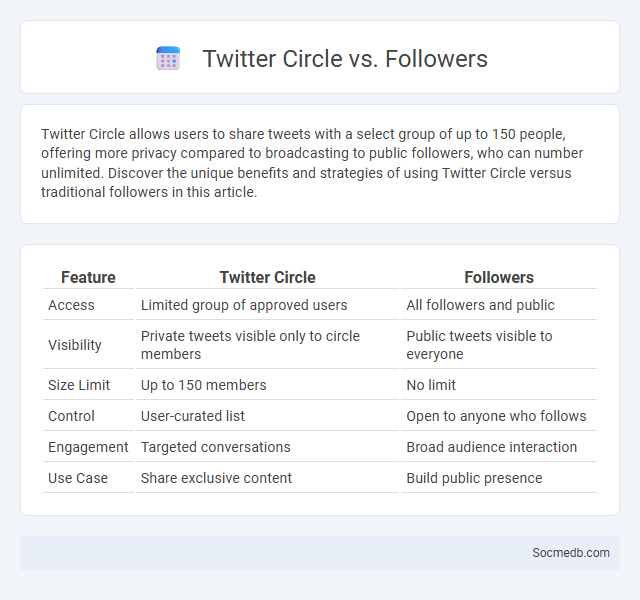
Photo illustration: Twitter Circle vs Followers
Twitter Circle allows users to share tweets with a select group of up to 150 people, offering more privacy compared to broadcasting to public followers, who can number unlimited. Discover the unique benefits and strategies of using Twitter Circle versus traditional followers in this article.
Table of Comparison
| Feature | Twitter Circle | Followers |
|---|---|---|
| Access | Limited group of approved users | All followers and public |
| Visibility | Private tweets visible only to circle members | Public tweets visible to everyone |
| Size Limit | Up to 150 members | No limit |
| Control | User-curated list | Open to anyone who follows |
| Engagement | Targeted conversations | Broad audience interaction |
| Use Case | Share exclusive content | Build public presence |
Introduction to Twitter Circle and Followers
Twitter Circle enables users to share tweets exclusively with a select group of followers, enhancing privacy and targeted engagement. Unlike public tweets visible to all followers, these messages are accessible only to members of the curated circle, fostering closer interactions. This feature complements the traditional follower model by allowing more controlled and intimate communication within the platform.
What is Twitter Circle?
Twitter Circle is a feature that allows users to share tweets with a select group of people, creating a more private and controlled sharing experience. Your tweets in a Twitter Circle are visible only to those you include, enhancing confidentiality and fostering closer interactions. This feature is ideal for sharing personal updates or exclusive content without broadcasting to your entire follower base.
How Twitter Followers Work
Twitter followers represent users who subscribe to another account's updates, allowing them to see tweets, retweets, and interactions in their feed. The number of followers impacts account visibility, engagement rates, and social influence within the platform's algorithm. Users increase followers through consistent content, interaction, and use of hashtags to target relevant audiences and enhance discoverability.
Key Differences Between Twitter Circle and Followers
Twitter Circle allows users to share tweets with a select group of up to 150 people, providing a more private and controlled audience, whereas followers represent a broader, public audience that can range from a handful to millions. Tweets shared within a Twitter Circle are visible exclusively to circle members, enhancing exclusivity and targeted communication, while tweets sent to followers are accessible by anyone following the account, increasing reach and engagement potential. The Twitter Circle feature emphasizes user privacy and intimacy, contrasting with the typical public nature of follower-based interactions on the platform.
Privacy Settings: Twitter Circle vs Followers
Twitter Circle offers enhanced privacy by allowing You to share tweets exclusively with a select group of up to 150 trusted followers, ensuring more controlled visibility compared to the broader public audience of all followers. Unlike your general followers who can see your public tweets, Twitter Circle enables targeted communication, reducing exposure to unwanted interactions or scrutiny. Adjusting privacy settings between Twitter Circle and follower groups empowers You to manage your online presence with precision and safeguard sensitive content effectively.
Engagement and Interaction Comparison
Social media platforms differ significantly in engagement and interaction metrics, with Instagram and TikTok leading in visual content responsiveness through likes, comments, and shares. Facebook maintains strong interaction via group discussions and event participation, while Twitter excels in real-time conversations and retweets. Understanding these differences helps you tailor your content strategy to maximize audience interaction and boost overall engagement effectively.
Content Sharing in Twitter Circle vs Followers
Content sharing within Twitter Circle allows users to share tweets exclusively with a curated group of up to 150 trusted followers, enhancing privacy and targeted engagement. In contrast, sharing with all followers broadcasts content to a broader audience, maximizing reach but reducing control over who views the post. Twitter Circle is ideal for personalized interactions, while sharing with followers is suited for public updates and widespread visibility.
Managing Your Audience: Circle vs Followers
Managing your audience on social media involves understanding the distinct dynamics between Circles and Followers; Circles allow you to create segmented groups for targeted content sharing, enhancing engagement through personalized interactions. Followers represent a broader audience, offering wide-reaching visibility but less control over content customization. Utilizing Circles effectively helps you tailor your messaging to specific groups, improving communication and fostering stronger community connections.
Pros and Cons of Twitter Circle and Followers
Twitter Circle offers users a way to share tweets with a select group, enhancing privacy and fostering more intimate conversations compared to public followers. However, limiting interactions to a Circle may reduce the reach and engagement that comes from a broader follower base. Balancing these aspects is crucial for users seeking targeted communication without sacrificing audience growth.
Which Option is Best for Your Twitter Strategy?
Choosing the best option for your Twitter strategy depends on your goals, target audience, and content type. Analytics tools like Twitter Analytics offer detailed insights into tweet performance and audience behavior, enhancing engagement and reach. Integrating scheduling platforms such as Hootsuite or Buffer ensures consistent posting, optimizing visibility and interaction with followers.
 socmedb.com
socmedb.com